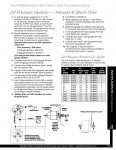If you don't see a wiring issue right off the bat,
As a static test of the gauge you could always use a jumper wire and short the "S" terminal to ground and deflect the needle fully.....but that can give a indeterminate at times depending on how things are failing,
If the water, fuel and oil all have same/similar resistive curves as per their respective temp/level/pressure as Scott has indicated and you want a bit more of a linear test (less having a potentiometer in the kitchen drawer like myself), then as a
trouble shooting aid, I'd be inclined to be swapping a "S" wire from a known good sender (water, fuel) to eliminate or confirm a suspected bad gauge/sender (oil)........
For example, if the known good sender (fuel) is used and you have a half tank of gas (approx 100 ohms), you should read *50 psi of gas in the tank

connecting the fuel sender's "S"
wire to the oil pressure gauge "S"
terminal. If confirmed as such, this would be of course indication of a bad oil sender
(or wring path).
See "fuel" and "oil" details/resistance values in the below images.
*assumes the oil gauge is a 100 psi full scale























